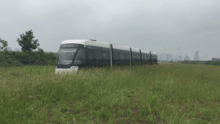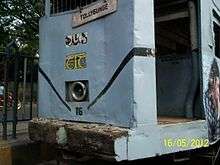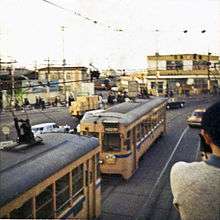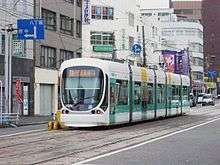Trams in Asia
Tramway Systems in the Asian region were well established at the start of the 20th century, but started to decline in use in the 1930s. By the 1960s, the majority of systems had been closed down. Extensive tramways still exist in Japan and Hong Kong. Recently, more modern systems have been built in China.
China

Several cities in China had tram systems during the 20th century however, by the end of the century, only Dalian and Changchun remained extant.[1]
- Beijing had the first tram system in China. It opened in 1899 and connected Ma-chai-pu Railway Station to the south gate of the city.
- In Nanjing had a new Hexi trams installed before the 2014 Youth Olympics

- Fushun city in Liaoning province had a tram system circa 1902, operated by the Manchuria Railway Company with 26 trams.
- Tianjin city, had a tram system that opened in 1906. By 1933 it had 9 miles of track and operated 116 tramcars. It was closed by 1972.
- The Changchun tramway system started operations in 1942. By the 1950s the system covered 28 km with 98 cars. The system continues to operate today.
- In Shanghai there were three tram systems - two operated by the colonial powers of Britain and France and one by a Chinese company. The British system opened in 1908 and was the largest of the three. It had 7 lines and ran 216 tramcars. The French system opened the same year and its 3 lines ran 60 tramcars. The Chinese system opened in 1913 and operated 52 tramcars over 4 lines of some 23.5 km in length.
- In Shenyang city, the largest city of Liaoning province, a Japanese owned electric tramway opened in 1925 and replaced an earlier horse-drawn tram system that dated from around 1907.[2] By 1937 it had expanded to cover 12 km of track and ran 21 tramcars. It was finally closed in 1973.
- Harbin city in Heilongjiang province had a system from 1927 with 8 lines and about 40 trams. The system closed in 1987.
- The city of Anshan, in Liaoning, had a single tram line from 1956 till the late 1990s and the track was dug up in 2006.
- Dalian city in Liaoning opened its first tram line on September 25, 1909. It was operated by South Manchuria Railway. By 1945, the system had 11 lines. Today 2 lines remain in operation covering 23.4 km. The system is in the process up being updated with a mixture of old tram cars and new modern low floor cars in operation.
Tianjin and Shanghai have recently introduced rubber tired trams for their TEDA Modern Guided Rail Tram and Zhangjiang Tram respectfully.
In 2011, Shenyang city decided to construct a new tram network to complement its new metro network, then under construction. The first three lines of the new system were opened on August 15, 2013: Line 1 from New World International Convention & Exhibition Centre to Taoxian street, line 2 from Taoxian Airport to the Olympic Center and line 5 from the Olympic Center to Shenfu New Town. A fourth line is under construction.[3]
Wuhan, Beijing, Qingdao and Haikou have new tram systems under construction. While Shenzhen [4][5] and Ningbo are planning tram networks for the future.
Hong Kong

The tramway system was introduced in the then British colony in 1904. The Hong Kong Tramway is a traditional British Isles-style double-decker tramway with street running, along the north shore of Hong Kong Island. Since the 1990s, the MTR Light Rail system has opened in the north west New Territories. Despite its name, the famous Peak Tram is actually a funicular railway.
India


In India, the city of Kolkata (Calcutta) has a tram network. Chennai (Madras), Kanpur, Delhi, and Mumbai (Bombay) formerly had tram networks but these have been dismantled. The Kolkata tram is the oldest operating electric tram system in Asia, running since 1902.
Indonesia
In Batavia (now Jakarta), the capital of the former Dutch colony of the Netherlands East Indies, a horse tram service started in 1869. A steam tram ran from 1881, and electrification followed in 1897.[6] All Jakarta trams were discontinued in the 1960 by an independent Indonesia due to pressure from Sukarno which saw tram network as "antiquated" and "relic of colonial era".[7]
The other cities in Indonesia who used to have urban tram network were Surabaya and Semarang.
Semarang tram network was constructed between 1882 and 1883, and it was essentially the inner suburb extension of Samarang Joana Railway (SJS) network, where they already had extensive rural tram network to the east of Semarang. Unfortunately, due to financial difficulties that hampered SJS railway company, Semarang tram network was closed down in 1940 (despite public protest in Semarang) and their rolling stocks were transferred to Surabaya tram network.[8]
Surabaya tram network was first built in 1886.[9] Initially consist of steam tram only, but later another network of electric tram was added in 1923. They served Surabaya commuters well into the independence era. The electric tram bowed out from service in 1968, while its steam counterpart outlived the electrics before bowed out from service in 1978, making it as the very last urban steam tram service in the world to see service.[10]
In 2012 there is a talk of reviving Surabaya's tram network as a part of Surabaya Mass Rapid Transit project, which will see parts of the old electric tram right of way reactivated, and it will be combined with the future monorail network.[11] The project is aimed to alleviate Surabaya's traffic congestion and provide cheap public transportation for Surabaya commuters.[12] As in 2014 the project have entered tender phase.[13]
Japan

The first tramway in Japan was the Kyoto electric railroad built in 1895. By 1932, there were 82 street railway companies in 65 cities, with 1,479 km of track. Like other parts of the world, many Japanese cities had extensive tram systems until the 1960s, when increased motorization made those networks disappear. Tokyo, for instance, had 41 routes in 1962, while only two routes (Toden Arakawa Line and Tokyu Setagaya Line) still survive today.
There are still some cities with relatively well-kept networks. However, not many of them enjoy high riderships. Current tram systems include Sapporo Street Car (Sapporo) and Hakodate City Tram (Hakodate) in Hokkaidō; Tokyo Toden and Tokyu Setagaya Line in (Tokyo), Enoden (Kamakura), Toyohashi Railroad (Toyohashi), Toyama Light Rail and Toyama Chihō Railway (Toyama), Man'yōsen (Takaoka), Randen (Kyoto), Hankai Tramway (Osaka), Okaden (Okayama), and Hiroden (Hiroshima) on Honshū; Iyotetsu (Matsuyama) and Tosaden (Kōchi) on Shikoku; and Nagasaki Electric Tramway (Nagasaki), Kumamoto City Tram (Kumamoto), and Kagoshima City Tram (Kagoshima) on Kyūshū. Some extend into neighboring communities.
Trams were formerly used in Sendai, Yokohama, Kobe, Fukuoka, Kyoto, Nagoya, Osaka, among others.
North Korea
Pyongyang, the capital city of North Korea, has an extensive tram system that first opened in 1991. It is now 50 km in length running mainly ČKD/Tatra vehicles with some other trams originally from Zürich. Another tram system is present in the city of Chongjin.
South Korea
The South Korean capital, Seoul had trams up until the 1960s. Some of their cars were acquired second-hand from the Los Angeles system. The trams were very useful in the Korean War where half of the trams broke down. Trams were also formerly used in Busan.
Lebanon
Tram networks existed in Beirut under the French rule. These networks were no longer functional after the Lebanese Civil War.
Malaysia
The sole tram service in present-day Malaysia operated in George Town, Penang in British Malaya between 1906 and 1936; its service was discontinued in favor of trolleybuses (which would in turn be replaced by conventional diesel buses). Due to the relatively early retirement of streetcars in the city, few traces of streetcar infrastructure remain in George Town, with the exception of a stretch of paved-over streetcar railway rediscovered during roadworks in the late 2000s. Although talks on reviving the city's tram system have taken place since, none of these plans have materialized.
Pakistan

In Pakistan, Karachi was the first and only city where trams were introduced by the British Raj in 1885.[14] After almost 90 years, the network was closed in 1975 as trams were involved in many accidents and was an attempt to decongest the city's traffic.[15] Currently, a tram system is being built in Gwadar, with construction having started in late 2011. city's. Trams are also under construction at DHA City, Karachi which is going to be a planned city of 1 million people.[16]
Philippines
The Philippines once had a tram network in the capital, Manila, which first started in the 1880s using horse-drawn streetcars owned by Spanish-Filipino businessman Jacobo Zobel through the Companía de los Tranvías de Filipinas. These streetcars are known as the tranvía, or trambiya in the Filipino language. At the turn of the 20th century, horse-drawn tranvías of the Companía de los Tranvías de Filipinas were replaced by electric-powered streetcars as it changed ownership to the Manila Electric Railroad and Light Company, now known as the Manila Electric Company. The tranvía network ran throughout the city of Manila and its outskirts, Pasay, Makati, and Pasig. Much of the system was destroyed during the Battle of Manila in 1945.
The trams were superseded in the late 20th century by a still-growing urban rail network, beginning with the LRT in the late 1980s, followed by the MRT a decade later. Trams were also formerly used on the island of Corregidor.
Singapore
Singapore has historically operated two tram services, the first a steam tramway existing between 1886 and 1894, and the second an electric-powered system between 1905 and 1927. Singapore is considering the use of modern tramway systems, the first might be in the east (Tampines area). Singapore will also consider the use of trolleybus systems as well.
Sri Lanka
The Northern and Central areas of the City of Colombo had an electric Tram Car system (42" Gauge). This system commenced operations about 1900 and was discontinued by 1960. The original operator was the Colombo Electric Tram Car and Lighting Company Ltd. (represented by Boustead Brothers), and after an infamous Tram Car Strike, the Colombo Municipal Council took over operations. Subsequently, the tram car system was phased out.
Taiwan
The construction of a line began in June 2013 in Kaohsiung[17] and target to completed in mid-2016.
A demonstration line was built in 2004, but it is no longer in operation.
Thailand
The Bangkok electric tramway system was first introduced in 1893. It serviced Bangkok with 48.7 km of track and 206 trams. The tramway service was discontinued in 1968.
United Arab Emirates
The Dubai Tram opened in 2014 and became the first tramway system in the world to use platform screen doors at its stations[18] and the first tram system outside Europe to be powered by ground-based electric supply system.[19]
Uzbekistan
The Tashkent electrical tramway system was introduced in 1912 as a replacement of the horse-driven trams that were running since 1901. Tashkent tram system is the oldest in Central Asia, and was one of the biggest in the former Soviet Union. In the beginning of the 21st century the system has lost many of its routes, due to removal of track from the city center. The last route close on begin of may 2016.
Vietnam
In Vietnam, tram networks once ran in Hanoi and Ho Chi Minh City (formerly Saigon).
Saigon
Compagnie française des tramways de l’Indochine (CFTI) began tram services in Saigon in 1881 using cars towed by a steam locomotive designed by Decauville using 0.5m gauge line.[20] The system went bankrupt in 1896, but the system managed to survive using new cars (CFTI ordered 14 cars (trailers and locomotives) from Borsig of Germany) and expanded with two more lines in 1904 and 1913. Electric car service began in 1923 with new electric cars and eventually became 72 kilometres (45 mi) system with 2 lines served. Tram service ceased in 1953-1954 and the system was dismantled by 1957.[21]
Hanoi
Hanoi's tram system, Compagnie des tramways électriques d’Hanoï et extensions, began service in 1900 and was acquired by Compagnie des tramways du Tonkin in 1929 (renamed Société des transports en commun de la région de Hanoi in 1952). By 1943 the system had 5 lines and a spur line in 1968.[22] The system's demise began with line closure in 1982 and survived until the last line closed in 1989.[23] and continued as a trolley bus system until 1993. All the tram cars were imported from France.
Hanoi Tram Lines
- Line 1 - Petit Lac (Hoàn Kiếm Lake)-Bạch Mai (1901-1982)
- Line 2 - Giấy (Bưởi Market) (1901-1989)
- Line 3 - Petit Lac-Pagode des Corbeaux-Thái Hà Ấp (1904-after 1982)
- extended to Hà Đông 1914 and Cầu Đơ market 1938
- Line 4 - Place des Cocotiers-Pagode des Corbeaux-Pont du Papier (Cầu Giấy) (1907-1986)
- became trolleybus line 1986-1993
- Line 5 - Mandarine-Kim Liên-Place Neyret-Yên Phụ (1930-after 1982)
- extended to René Robin Hospital 1943
See also
References
- ↑ "China's Old Tram Systems - A Quick Round Up". China Rhyming. 25 February 2009. Retrieved 19 September 2013.
- ↑ Crush, Peter. "Kaiping Railway -China's second "first" railway". Hong Kong Railway Society. Retrieved 19 September 2013.
- ↑ "Shenyang tramway opens". www.railwaygazette.com. Railway Gazette. 15 August 2013. Retrieved 19 September 2013.
- ↑ http://szdaily.sznews.com/html/2013-12/30/content_2738108.htm
- ↑ Han, Ximin (10 October 2012). "9.1-km tram planned in Longhua". Shenzhen Daily. Retrieved 19 September 2013.
- ↑ Teeuwen, Dirk. From Horsepower to Electrification: Tramways in Batavia-Jakarta 1869-1962, 2010
- ↑ http://mijn-wagen.blogspot.com/2012/05/transportasi-tram-indonesia-masa-lalu.html
- ↑ http://tjahjonorailway.blogspot.com/2009/06/semarang-city-tram.html
- ↑ http://ayorek.org/en/2013/07/trails-life-behind-surabaya-tram/
- ↑ http://www.internationalsteam.co.uk/trams/steamtram22.htm
- ↑ http://smart.surabaya.go.id/?lang=en
- ↑ http://www.thejakartapost.com/news/2013/12/20/surabaya-gearing-rp-86-trillion-mrt-project.html
- ↑ http://www.indonesia-investments.com/doing-business/business-columns/international-tender-surabaya-monorail-and-tram-project-in-december-2013/item1336
- ↑ Jang 4 April 2010
- ↑ Karachi Tramway of Yesteryears
- ↑ http://dhatoday.com/sustainable-transportation-in-dha-city-karachi-dck-all-you-need-to-know/
- ↑ "Kaohsiung begins circular light rail construction". Focus Taiwan. 2013-06-04. Retrieved 2013-07-23.
- ↑ "Al Safouh tram project consortium selected". Railway Gazette International. 29 April 2008. Retrieved 12 March 2015.
- ↑ http://www.khaleejtimes.com/kt-article-display-1.asp?xfile=data/transport/2014/April/transport_April19.xml§ion=transport
- ↑ http://www.historicvietnam.com/sai-gon-tramway-network/
- ↑ http://www.historicvietnam.com/sai-gon-tramway-network/
- ↑ http://www.historicvietnam.com/ha-noi-tramway-network/
- ↑ http://www.historicvietnam.com/ha-noi-tramway-network/
